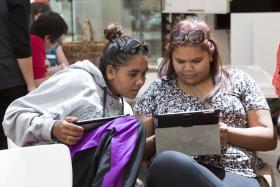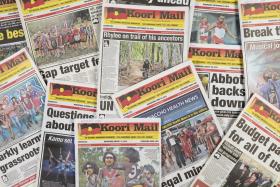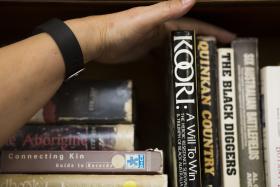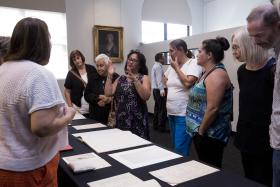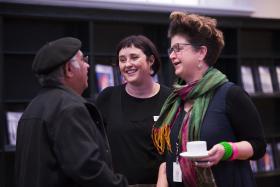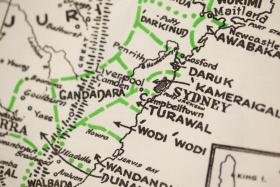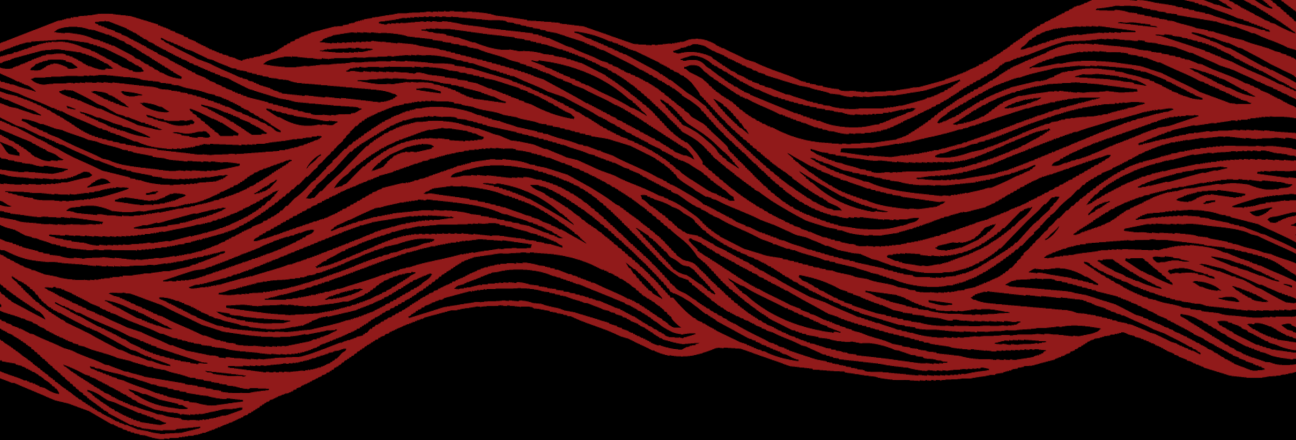
Build vibrant collections and services
Indigenous Spaces In Library Places Public Library Toolkit
Build vibrant collections and services that are shaped by Indigenous needs and aspirations
Targets
- Collections relating to Australian Indigenous culture and history are developed and are made visible throughout the public library network.
- Events and programs related to Indigenous Australian culture, history and experiences are incorporated into regular planning across the network.
- Collections and services dedicated to Indigenous peoples and communities are developed with respect to the ATSILIRN protocols.
Key strategies
- Provide information to public libraries on the development of Indigenous collections, including key reference titles.
- Support the provision of tools, templates and guides online relating to the development of and access to Indigenous services and collections.
- Share with public libraries staff case studies developed on the ATSILIRN protocols and their application.
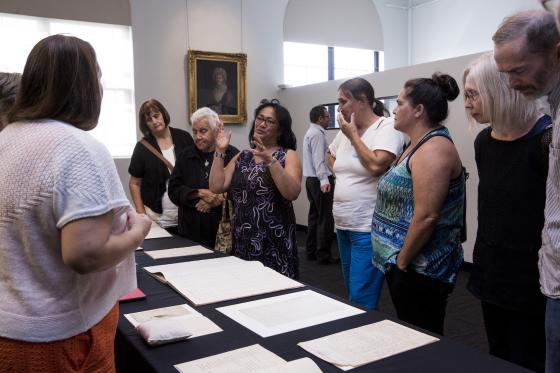
Resources for public libraries
Getting started
A good collection is one that all the community finds valuable, and that celebrates Indigenous cultural resilience and continuity. It is useful to read the National State Libraries Australasia (NSLA) National position statement for Aboriginal and Torres Strait Islander library services and collections to get a better idea of the importance of library collections in representing Indigenous history in NSW and the rest of the country.
It is appropriate to label the resources in your library which include information on Indigenous histories and cultures. Many libraries use labels with an Aboriginal flag design on the book spines. Spine labels are available from library suppliers. You can also print and use an example from this online toolkit.
Aboriginal and Torres Strait culture in Australia is living and contemporary, it is important to reflect this in public library collections and not to be restricted to historical viewpoints. It is also important to seek out Aboriginal authors and perspectives. One way to keep abreast of new publications is to follow Indigenous publishing houses and suppliers including:
- Magabala Books
- IAD Press and Angkitja Books (formerly Jukurrpa imprint)
- Aboriginal Studies Press (AIATSIS)
- University presses (eg. Batchelor Press)
- Ask your local land council and community members to let library staff know of new local publications. These may be acquired for library collections as appropriate.
Other avenues for finding notable new titles include:
- Award shortlists frequently highlight Aboriginal authors and Indigenous themes (e.g. CBCA Children’s Book of the Year, Notables List; Indigenous Writers Award, Speech Pathology Australia include a category for Indigenous Children in their annual book of the year awards)
- Booklists compiled by readers, bookshops and book bloggers.
Curating books with the assistance and consultation of community is a good way of adding to your collection, if there is a lack of commercial local content.
Consider a wide range of material for your collections including:
- Family History and Local History
- Fiction
- Encyclopaedias (e.g. Horton, David ed (1994) The Encyclopaedia of Aboriginal Australia: Aboriginal and Torres Strait Islander history, society and culture. Australian Institute of Aboriginal and Torres Strait Islander Studies. Canberra, ACT.)
- Sciences (e.g. agriculture, astronomy, bush medicine)
- History
- Arts and sports
- Language and culture
Newspapers and Journals
- Aboriginal History
- Koori Mail
- National Indigenous Times
- First Nation Telegraph
- Cape York News (Torres Strait)
- Land Rights News Northern Council and Land Rights News Central Council
Photographs
Photographs are valuable community records. They can illustrate a person's or family's connection to community and Country. Old photographs, such as images of sporting teams or local schools, can demonstrate community cohesion over generations.
To enhance your collection, you could consider taking photos of the various programs that you conduct with members of the local Indigenous community. You could also consider building your photographic collection by commissioning a local person to take photos of significant events, such as NAIDOC festivals or ceremonies held in the community.
Online & born digital
Public libraries provide an important space in the community to access online and born digital collections. A good place where to start is the Digital Practice and Guidelines page on the Library's website, which provides an introduction for public libraries that are involved in digitisation projects, including providing access and storage for born digital objects and digital preservation.
Tip
It is useful to review your Indigenous collection often, to ensure that:
- The resources offered by your library are up to date
- Your collection is relevant for your community and include local history resources
- There is a balance between historical and contemporary texts
- Anthropological texts are carefully checked as they can be considered racist and offensive in today’s context. As a rule, texts written before 1960 may require careful examination.
Getting started
The library is an important place for clients to identify resources, particularly for family history research. Indigenous family history collections are held in major cultural institutions across Australia. Public libraries can assist Indigenous peoples in trying to locate and access these materials locally. This type of engagement is a great way to attract the local Indigenous community to your library service.
To provide assistance to Indigenous people seeking advice with their family history, you can start with the usual resources your use to trace general Family History:
The Library Aboriginal Australian Family History Research Guide provides a great introduction on how to assist your Indigenous clients in tracing their family history.
Working together
The following specialist resources have been produced by different institutions from across the country and can help in finding more specific information on Indigenous peoples and families.
NSW and National
First Australians - National Archives of Australia
Aboriginal Resources: Guide to NSW State archives - State Records of NSW
Finding your family - Australian Institute of Aboriginal and Torres Strait Islander Studies (AIATSIS)
Bringing them Home Index - Australia Government and National Archive of Australia
Link - Up NSW
Family Records Service - NSW Aboriginal Affairs
Proof of Aboriginality - AIATSIS
Aboriginal and Torres Strait Islander peoples military records - Australian Government Department of Veterans' Affairs
States other than NSW
Finding your Aboriginal History - State Records of South Australia
Indigenous Services - State Library of South Australia
AA 338 Dr. Norman Barnett Tindale. Guide to Records - South Australian Museum
Walata Tyamateetj. A guide to government records about Aboriginal people in Victoria - Public Record Office Victoria and the National Archives of Australia
Aboriginal people and family history - State Library of Victoria
Aboriginal Records at PROV - Public Record Office Victoria
Koorie Heritage Trust’s Koorie Family History Service - Koorie Heritage Trust
Aboriginal and Torres Strait Islander family history - State Library of Queensland
Indigenous Resources - Queensland State Archive
Indigenous Family History - State Library of Western Australia
Aboriginal History Research Services - Western Australia, Department of Local Government, Sport and Cultural Industries
Library and Archives NT - search the Northern Territory archives and library
Getting started
Organise events and programs related to Indigenous history and culture is a great way your library can attract the entire community. This will result in more participation in your library activities, enhanced word of mouth and potential partnerships opportunities with other institutions such as Local Councils and schools.
Tip
The following websites give interesting ideas on celebrations and historical milestones:
- Historical Milestone – National Museum of Australia
- Aboriginal and Torres Strait Islander veterans – Australia Government Department of Veterans Affairs
- How to run a great book swap - Indigenous Literacy Foundation
- Indigenous Events – Australia Government
Working Together
Some ideas to organise events and programs related to Indigenous culture and history may include:
Celebrate major events for Indigenous peoples
It is important to celebrate the most important key dates for Indigenous people nationally. In this toolkit you will find a calendar of key dates on Indigenous culture and history.
Organise events and programs in the library
Some ideas may include:
- Storytime
- Family history workshops
- Internet and Social media
- Tech savvy
- Arts and crafts activities
- Indigenous languages workshops
- Possum Skins Cloak Story Quilt
- Book clubs
- Oral history sessions
- Health or Law information sessions
- Local food tasting workshops
- Writing workshops
- Jobs skills workshops
- Videoconferences
- Talks of local community member
- Videos
- Exhibitions and displays
- Competitions (such as Writers competitions)
- Visits of Indigenous authors and artists
- School holidays
- Seminars
- Close the Gap morning tea
- Harmony Day events
- Local artist of the month
- Reconciliation Groups and/or book clubs
- Meeting place for storytellers
Tip: Customise the calendar to include your local celebrations by downloading the Key Date Calendar word document.
Host events of other organisations
Liaise with Indigenous associations in your area and invite them to use the space of your library.
Tip: Advertise adequately across the key Indigenous peoples and organisations ensure people will be aware of what is going on. It is also important to seek for feedback during and after the event to see how the library can improve.
Collaborate in organising events in other local organisations
- Ask museums, galleries
- Outreach, pop-up libraries
- After schools and other associations
- Study groups
Tip: talk to your local community to see if you can partner a local event in your library.
Children's programs
To better engage children and their families, it is important to add a local Aboriginal aspect to your programs. Examples of services you can provide in your library may include:
- Storytime sessions
- Homework hub
- School holiday programs
- Cultural craft workshops
- Illustrators workshops
Downloadable Resources
Getting started
If your library is used as a meeting place for different part of your community, these regular activities could be your best opportunity to interact with the local Aboriginal community. Remember these services or groups do not necessarily have to have an Aboriginal subject focus.
Family and local history groups
This group meets regularly to memorialise your local people, town and community. The outcomes of group could be the consolidation of local knowledge and the creation of collection material.
Examples may include:
- Family history month
- Back to “your hometown”
- Commemorate various local festivals, such as The Harvest Festival.
Home library
Sometimes clients are unable to visit the library. The Home Library Service could also include visits to Aboriginal community members to individuals, communities or shared infrastructures (such as retirement villages).
Writer groups
Elders and youth alike have stories that they would be happy to share and writer’s groups would be the perfect way to achieve this. The group could possibly focus on:
- Poetry slam
- Family history
- Local history
Book clubs
While not specifically aimed at the local Indigenous community your book club could focus on good contemporary Aboriginal and Torres Strait Islander publications. All book shops carry current publications but there are a few that specialise in Aboriginal and Torres Strait Islander resources. Below an example of the publishers you could purchase from:
Case studies
This case study was kindly provided by Jim Maguire, Library Manager at Port Macquarie library.
NAIDOC Celebrations - Port Macquarie Library
Each year, as part of the Naidoc celebrations, the library has had a presence at the Family Fun Day. Since 2013 this has involved taking the library van to the event to promote our services. From the library's perspective it is a great opportunity to engage directly with the local Aboriginal community and to ensure they are aware of the full range of programs and services we provide. At the event we have engaged in a range of activities, mostly aimed at children, including story sessions and craft activities with local totems. For the past two years we have run Virtual Reality demonstrations which have proven very popular with hundreds of participants sharing the experience.
This case study was kindly provided by Raquel Pickering, Librarian - Coonamble Shire Library.
Consultation with Aboriginal people of the Coonamble community during the local NAIDOC event revealed a high proportion of Aboriginal people surveyed did not consider the library to be relevant to them. However, a high proportion desired opportunities for social, educational and community connections.
Coonamble library implemented a number of strategies that have made a big impact for little effort. We have now separated our collections to include an Indigenous Collection and tagged it as such with the Aboriginal flag and signage. This includes junior fiction, young adult, adult and non-fiction. All of these books are written by Indigenous authors or have an Indigenous subject. The Indigenous Literacy Foundation has been of tremendous support with this by helping to grow our collection and also offering ideas on what to include. We decided to leave our Indigenous picture books with the rest of the picture books as we have a dedicated children’s area and they are seen and borrowed a lot more frequently from that area.
Council sought expressions of interest from local Indigenous artists to submit artwork for consideration for purchase and display within the library and as a result we have over 20 artworks prominently displayed at the front of the building, which we believe shows that the library has a whole of community approach. We also include at least one Indigenous activity or lesson during each holiday. The library is one of the only organisations to provide art, sport and learning activities during the school holidays at no cost and it is heavily attended by both Indigenous and non-Indigenous children.
The library also participates in NAIDOC day each year. Last year we attended a Sports and Culture Carnival and took our tablet so we could show attendees our catalogue, the Indigenous collection and the children’s collection. We were based at a large table so we got a long roll of brown paper and coloured paints and had kids and adults paint their hand and press to the paper. We put their name and age under it and we displayed in the library along a wall with NAIDOC Day 2016 written on it. The kids loved coming in and seeing their hands and their names on the wall.
One of our greatest successes has been our Movie Night held fortnightly during school term at the library. Starting at 5pm when the library closes, a movie is shown on our big screen projector. Two Community Development Officers employed by Council run the night and we provide light refreshments including popcorn, water – and at intermission, sandwiches and cheese and biscuits. Attendee numbers can range from five to thirty five. We do not charge a fee or require bookings, just that each child be over 10 (unless accompanied by an adult) and have a form filled out by their guardian with contact numbers and any medical concerns. The majority of attendees have been of Aboriginal descent and the movies are G or PG movies that the library owns. On the whole, we believe that we have made Coonamble Shire Library a welcoming and inclusive space for both Indigenous and non-Indigenous people to visit.
Choose your strategy objective
Other resources for your library
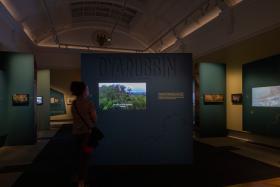
Indigenous Spaces in Libraries
Building culturally safe and welcoming spaces in libraries for First Nations peoples and communities.
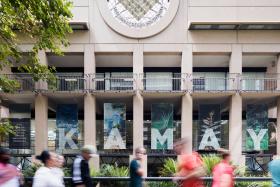
Guiding Principles and Indigenous Frameworks
Guidelines the Library follows for engaging with Aboriginal and Torres Strait Islander people and managing the collections

